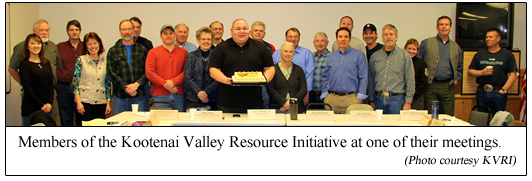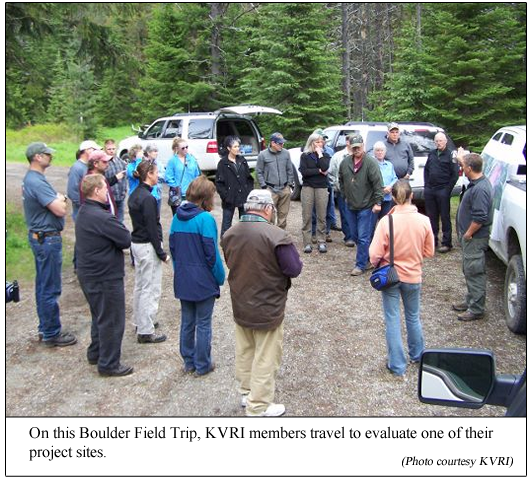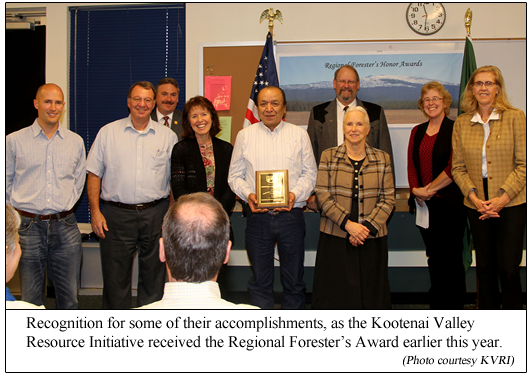|
|
|
Kootenai Valley Resource Initiative working hard
for Boundary County |
|
August 5, 2015 |
by McKenzie MacDonald
Working together to enhance the many resources
Boundary County has to offer while encouraging
and fostering community involvement and
collaboration—that is what the Kootenai Valley
Resource Initiative (KVRI) does for our
community. KVRI gives community members the
opportunity to collaborate for a common goal, to
engage with State and Federal agencies, to
provide a forum for the community to work
together in natural resource management and
planning, to exchange ideas and information and,
to provide a “sounding board” for involvement in
the community.
This initiative has been continually working in
Boundary County since 2001, shortly after the
Idaho Department of Environmental Quality and
the Environmental Protection Agency (EPA) began
looking at writing water quality plans for our
county. Believe it or not, water temperature is
considered a pollutant if it is too hot to meet
water quality standards. During this writing
process, it was discovered that many of Boundary
County’s streams were exceeding temperature
standards and it was proposed that the Kootenai
Tribe of Idaho, the City of Bonners Ferry, and
Boundary County work together to develop plans
to improve water quality. By developing
partnerships with multiple agencies, the KVRI
became what it is today.

Every day, KVRI Board and Committee members work
on projects that provide social, ecological and
economic benefits to Boundary County. The Board
consists of 11 appointed members, including
three Co-Chairs: Bonners Ferry Mayor David
Anderson, Boundary County Commissioner Dan
Dinning, and Kootenai Tribe of Idaho Tribal
Chair Gary Aitken Jr. KVRI’s efforts, however,
do not begin and end with the Board. KVRI
simultaneously operates within six different
committees, each consisting of between fifteen
and thirty members, most of whom are people who
live and work right here in Boundary County.
The KVRI committees are what provide the largest
opportunity for community involvement, as they
are open to anyone with an interest in joining
the effort. “We strongly encourage involvement,”
said KVRI Coordinator Patty Perry. “We have a
broad outreach to anyone who wants to be
involved.” While each of these committees may be
working on very different projects, they share
the same goal—enhance Boundary County’s natural
resources.
One such committee, the Forestry Committee, is
currently working to complete about 10 ongoing
projects. The goal of this committee is to “make
Boundary County National Forest lands
economically, ecologically and socially
sustainable,” according to a KVRI information
packet. Because Boundary County has so many
endangered animals living in habitats within our
county borders, these restoration projects have
not been without controversy or communication
with federal agencies like U.S. Fish and
Wildlife, the EPA, and the Army Corps of
Engineers. “KVRI decided it was better to engage
the agencies,” said Ms. Perry.
(Story continues below this photo).

This proactive communication has allowed KVRI to
work with the Forest Service toward restoration
of some of our forest land. This restoration
includes increasing fire resistant tree species
and improving our wildlife habitats. In
collaboration with KVRI, the U.S. Forest Service
was awarded a grant for 12 million dollars to be
used over the course of ten years. Part of this
money goes to restoring the forest by removing
lodgepole pine trees and restocking the forested
areas with more resilient species. With these
efforts, our forests will not only be more fire
resistant, but will also be more resistant to
diseases. This new-found resistance will also
enhance habitats for fish and wildlife, provide
more opportunities to make use of the land for
economic benefit, and allow for higher-quality
outdoor recreation activities.
Another committee, the Wildlife Auto-Collision
Committee (the WAC Committee), is hard at work
making our roadways safer. Each year, many
terrible injuries result due to wildlife along
the roadways. Currently, the WAC Committee is
working closely with the Idaho Transportation
Department and the Nature Conservancy to develop
a wildlife detection system utilizing Doppler
radar technology. The primary focuses for this
group are the McArthur Lake and Camp Nine areas,
as they can easily be considered collision
“hot-spots.”
While KVRI’s project funding comes mainly from
grants, the initiative itself is funded by the
Kootenai Tribe of Idaho, Boundary County, and
the City of Bonners Ferry. For all of the work
it does, the group operates within a very
limited budget. However, these budget
limitations do not seem to hinder any efforts!
What is spent on these projects, however, is
miniscule compared to the benefits that have and
will be brought to Boundary County due to KVRI.
The economic benefit of each restoration
project, “rolls through the community several
times,” said Ms. Perry. When KVRI provides
restoration opportunities, it simultaneously
provides jobs for loggers, contractors, and
mills.
While economic improvement is important,
projects will not happen purely for that reason.
“We call it the three-legged stool test,” said
Ms. Perry. This test ensures that the
restoration project will provide economic,
social and ecological benefits to this
community. “We won’t do something to make a lot
of money that isn’t socially acceptable,” she
said. This test ensures that each project
benefits the community in more ways than one and
allows KVRI to continue their efforts.

|
|
|
|
Questions or comments about this
article?
Click here to e-mail! |
|
|
|
|

